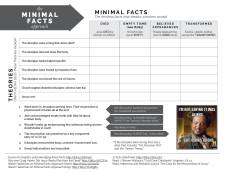 (Last published 9/23/11. Added 4/10/13: Video. Also see Audio Resources by Tim McGrew and Internal Evidence for the Gospels by Tim McGrew on Apologetics315.)
(Last published 9/23/11. Added 4/10/13: Video. Also see Audio Resources by Tim McGrew and Internal Evidence for the Gospels by Tim McGrew on Apologetics315.)A few months back I heard an April 24, 2011 radio interview on this topic, by fellow Christian Apologetics Alliance member Tim McGrew, and have been interested ever since. I really, really hope Tim writes a book of all these undesigned coincidences.
An undesigned coincidence happens when one part of the Bible is missing a detail that makes us ask a question, and another part of the Bible (a part authored by someone else), or a text external to the Bible, without collusion, supplies that missing detail. It is a test for historical authenticity.
Here is one talk at First Baptist Church of Kenner, LA (New Orleans area) in January (also available here).
Check out the July 30 and August 11 (both in 2011) podcasts on Frank Turek’s “Cross Examined” radio show.
Examples from here:
#1: Matthew 26:67-68 Why ask him to tell them who slapped him? Luke 22:64 They blindfolded him.
#2: Mark 6:31 Why are many coming and going? John 6:4 The Passover pilgrimage.
#3: Matthew 8:14-16 Why in the evening? Mark 1:21 Sabbath over at evening (cannot bear burden).
#4: Luke 9:36 Why did they keep silent? Mark 9:9 Jesus told them to tell no one (most consistently disobeyed command, lol).
#5: John 6:5 Why pick Philip? Luke 9:10 The setting of the miracle is Bethsaida, Philip’s “hometown” (John 1:44). (And see #17.)
#6: Bauckham: Names in NT are independently, statistically shown to be in very good accord w/ the frequency w/ which Jews named their children these names in Palestine. Most common male name: Simon. Second most common: Some variant on Joshua/Jesus. In Alexandria, most common name: Sabbatheus—no such character in NT.
#7: John 21:15 Why ask “…more than these?” Matthew 26:33 “Though they all fall away…I will never fall away.” In John 21:16 Peter is done boasting and just says “Lord, you know that I love you.” Beautiful!
#8: Luke 23:1-4 Why Pilate find no guilt in Jesus? John 18:36 “My kingdom is not of this world.”
Also, John never mentions the charge against him, but Luke fills in the detail.
#9: Matthew 2:22 Why does Archelaus’s reign spook Joseph? Why Galilee? Josephus’ Antiquities, Book 17: Archelaus sends troops into the temple and kills 3,000 Jews…Passover cancelled. The Jews Joseph meets in Matthew 2 are fleeing this. Galilee under control of Herod Antipas.
From here:
#1, #3, #4, #5, #7, #8
From here:
#4, #3, #5, #7, #8, #2, #9
#10: Matthew 14:1-2 Why is Herod speaking about this to his servants? Luke 8:3 Joanna, the wife of Chuza, Herod’s household manager/steward. Herod knows that if he’s got questions about Jesus, talk to his Christian servants. Acts 13:1 Manaen had been brought up with Herod the Tetrarch.
From here:
#11: Mark 14:57-58 Mark 15:29 People mock him for saying he would destroy the temple. He never says that in Mark. John 2:18-19 Jesus says, “Destroy this temple, and in three days I will raise it up.”
#9
#12 Luke 3:14 Why active-duty soldiers in a time of peace? Josephus: Herod Antipas got in trouble with his wife’s father when he fooled around with his brother’s wife, so he had a border war on the southeastern flank of his territory. Jordan river runs southward.
#13 Luke 3:2 Two high priests? Josephus: Book 18, Chapter 2 of Antiquities … one high priest by right (ruling through his sons), one high priest by Roman appointment. The Jewish War Book 2 Chapter 12 Section 6 “both” Jonathan and Ananias.
#14 Luke’s census. Two problems: 1) No record Caesar Augustus taxed whole Roman empire. 2) Quirinius was governor in 6 a.d., not 6 b.c.. Answer: “all the world” is Judea (same idea in Acts 11:28…Greek word means “the region in interest”…there is no word “Roman” in the Greek). The taxation is a registration or enrollment, not an actual taxation. “This was made” means “set in motion”. Read this way: “This first tax was put in use a dozen years later.” Also possible Quirinius had two stints as a governor. (See also Cheney’s comment here, section 10.)
#15 Luke 20:24-25 “Show me a denarius. Whose likeness and inscription does it have?” Look at Roman denarius. Not only does it have Tiberius Caesar’s face, but the inscription promotes worship of the previous Caesar. Jesus says “Render to Caesar that which is Caesar’s. Render to God that which is God’s.” In other words, the previous Caesar is not God, and this coinage with a ‘graven image’ is not ‘of God’.
#16 John 5:2 Are the 5 porches a literary device? Archaeology says no—it’s real. Also, John says “Now, there IS…” which means he must be writing pre-75 A.D. (before the destruction).
Via email 9/23/11:
#17 “This one just occurred to me: Matthew 11:21 — ‘Woe to you, Chorazin! Woe to you, Bethsaida! For if the mighty works done in you had been done in Tyre and Sidon, they would have repented long ago in sackcloth and ashes.’ What mighty works in Bethsaida? Matthew gives us no clue; this is the only time he ever mentions Bethsaida. Nor can Mark help us here, nor John. But turn to Luke 9:10 — On their return the apostles told him all that they had done. And he took them and withdrew apart to a town called Bethsaida. … and then comes the feeding of the 5000.” (See #5.)
Tim mentions these books, most/all available at historicalapologetics.org:
John James Blunt’s “Undesigned Coincidences”
William Paley’s “Horae Paulinae” (part 2) and “A view of the evidences of Christianity”
Edmund Hatch Bennett’s “The Four Gospels from a Lawyers’ Standpoint
Nathaniel Lardner “Credibility of the Gospel history” (17 volumes—have at it!)
Post a comment here or discuss at the following forums:
http://www.ilovephilosophy.com/viewtopic.php?f=5&t=176514
http://iloveopinions.com/index.php/topic,4373.0.html
http://www.sciencechatforum.com/viewtopic.php?f=46&t=19845
http://www.rationalskepticism.org/post985708.html#p985708
http://www.project-reason.org/forum/viewthread/22069
***
This post also appeared on Examiner.com.










This is excellent, Maryann! Thank you!
Yeah this stuff rocks :)
Ichthus777 has posted this on the(mostly) atheist forum RationalSkepticism. You can read the comments it elicited here:
http://www.rationalskepticism.org/christianity/undesigned-coincidences-in-the-gospels-t25252.html
Thanks Shrunk. I also posted it at ILovePhilosophy.com, ILoveOpinions.com, Project-Reason.org and PhilosophyChatForum.com, for anyone who would like to read the comments on those forums. However, this applies more accurately to the coincidences internal to the gospels, reflected in this post: http://ichthus77.blogspot.com/2011/09/undesigned-coincidences-in-gospels.html
Shrunk, I discontinued my participation in the Rational Skepticism thread, but if you'd like to continue it here (or in the thread to which I just linked), you are more than welcome, provided you have actual arguments. :)
Oh I just noticed–I did directly link to the threads at the end of the original post :)
Here's an actual argument: a common source isn't the same thing as authenticity.
Even if the “unintended coincidences” worked as you claim they do, all they would show is that the gospel authors — writing a good 40+ years after the events they claim to describe — had picked up on something that entered the Jesus-tradition between Jesus' crucifixion and the AD 60s-70s Jewish War.
Say a story about Jesus' trial got incorporated around AD 50. The gospel authors, writing several decades later, have no way of fact-checking it, and include it. So you have a common source: but it's inauthentic.
If a methodology fails in its stated purpose, then the only sensible course is to find a new one!
Byron, see example number 16. And if you are right that they were merely picking up on some fiction that entered the tradition, you would 'not' expect to find these unintended coincidences.
Why not? Nothing in the above reply shows why inaccurate transmission must be ruled out.
#16 notes that the gospels contain history. Of course they do! I doubt even Jesus-mythers (which I ain't) would dispute that. The question is how much history survives the redaction process.
(As for dating John's Gospel to pre-AD75, I've no problem with an early date in principal, but it takes more than one reference to the Pool of Bethesda to settle it. Other factors, like the Docetic elements, and the references to the Jesus-movement's expulsion from the synagogues, have to be considered.)
Howdy Byron–check out the new undesigned coincidence, #17 :)
Duly checked, but I don't see why another example of a method with which I disagree is likely to persuade!
Maryann,
Just a thought. You might want to preface this post with an explanation of why undesigned coincidences are compelling. Byron's comments reflect a misunderstanding of the nature of undesigned coincidences and why a common source -even if one exists- is not sufficient or plausible as an explanation. I know Tim discusses this in his talks, but it might be helpful to restate it at the beginning of these lists.
-Neil
Good idea Neil, thankyou.